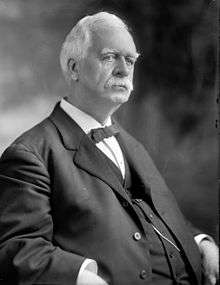Sereno E. Payne
| Sereno Elisha Payne | |
|---|---|
 | |
| House Majority Leader | |
|
In office 1899–1911 | |
| Preceded by | Office Created |
| Succeeded by | Oscar W. Underwood |
| Member of the U.S. House of Representatives from New York's 26th, 27th, 28th, 31st & 36th district | |
|
In office March 4, 1883 – March 3, 1885 (26th) March 4, 1885 – March 3, 1887 (27th) December 2, 1889 – March 3, 1893 (27th) March 4, 1893 – March 3, 1903 (28th) March 4, 1903 – March 3, 1913 (31st) March 4, 1913 – December 10, 1914 (36th) | |
| Preceded by |
John H. Camp James W. Wadsworth Newton W. Nutting Hosea H. Rockwell James B. Perkins Charles B. Smith |
| Succeeded by |
Stephen C. Millard Newton W. Nutting James J. Belden Charles L. Knapp Edwin A. Merritt Norman J. Gould |
| Personal details | |
| Born |
June 26, 1843 Hamilton, New York |
| Died |
December 10, 1914 (aged 71) Washington, D.C. |
| Political party | Republican |
| Alma mater | University of Rochester |
| Profession | Law |
Sereno Elisha Payne (June 26, 1843 – December 10, 1914) was a United States Representative from New York and the first House Majority Leader, holding the office from 1899 to 1911. He was a Republican congressman from 1883 to 1887 and then from 1889 to his death in 1914. He was chairman of the House Ways and Means Committee for 12 years starting in 1899. The Payne–Aldrich Tariff is perhaps the most significant legislation he introduced during that period. He was known as a staunch protectionist.
Payne was born in Hamilton, New York, on June 26, 1843. He attended the Auburn Academy in Auburn, New York, and then graduated from the University of Rochester in 1864. A lawyer, he was admitted to the bar in 1866 and practiced in Auburn, rising to become the Cayuga County district attorney from 1873 to 1879. Payne served in a number of administrative roles for the city of Auburn, as city clerk in 1867–8, supervisor in 1871–2, and president of the board of education from 1879 to 1882. He was appointed a member of the American-British Joint High Commission in January 1899.
Payne was elected as a Republican to the Forty-eighth and Forty-ninth Congresses (March 4, 1883 – March 3, 1887). He was elected into the Fifty-first Congress to fill the vacancy caused by the death of Representative Newton W. Nutting and was reelected to the twelve succeeding congresses (December 2, 1889 – December 10, 1914). During his tenure, he served as chairman of the Committee on Merchant Marine and Fisheries (Fifty-fourth and Fifty-fifth Congresses), chairman of the Ways and Means Committee (Fifty-fifth through Sixty-first Congresses), and majority leader (Fifty-seventh through Sixty-first Congresses). He was reelected to the Sixty-fourth Congress but died before that term began.
He died on December 10, 1914, in Washington, D.C., and was buried in Fort Hill Cemetery in Auburn.
References
![]() This article incorporates public domain material from the Biographical Directory of the United States Congress website http://bioguide.congress.gov.
This article incorporates public domain material from the Biographical Directory of the United States Congress website http://bioguide.congress.gov.
- United States Congress. "Sereno E. Payne (id: P000153)". Biographical Directory of the United States Congress.
- Ways and Means reference
- List of majority leaders
